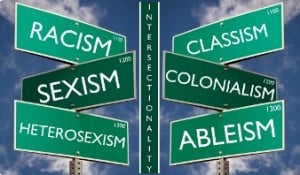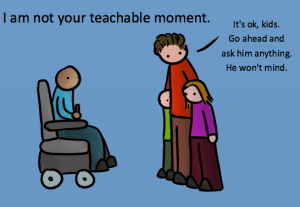As culture changes and newer freedoms allow more nuanced approaches to self-defining, new and unfamiliar terms and ideas spring up. Often, they cause massive amounts of confusion, frustration, and misunderstandings.
Like aromanticism.
Many people don’t see how it applies to relationships or they don’t believe that aros (as we call ourselves) are even relevant to larger discussions.
But I think you might be pleasantly surprised about all the things aros have to teach and expose about how embedded cultural norms surrounding love, sex, and romance limit us all in unhealthy ways.
So here I am, sharing my experience with you and busting some of the biggest myths about the aromantic identity.
No two aros are exactly alike. If you’re curious about the range of romantic orientations – from demiromantic to quoiromantic and beyond – here’s a great resource.
But here’s the basic definition: What most aros can agree on is that we have absolutely no experience of romantic attraction. It is our orientation, just like our sexuality. Many of us go through life as permanently single. We do not couple up, most of us don’t marry, and many of us prefer friendship over romantic or more traditional-looking relationships.
By contrast, romantic culture is pervasive, inescapable, and – at times – rather toxic.
Consider this: The largest and most important difference between my aromanticism and romance in general is the emphasis.
Romance is more about how you feel. How you feel affects what you seek, who you’ll choose, and how you’ll form relationships. Most cultures are built to actively support romantic bonds.
Aromanticism is more about trust. How much I trust someone determines who I’ll choose for whatever I desire, the choices I make about how to structure my life, and how I approach friendships.
So what’s the difference? As I understand it, many aros are perpetually single and are more into friendships than relationships.
But here are five ways that people commonly misinterpret that.
Myth# 1: All Aros Are Asexual
If aros are all geeked about friendship, then what’s the point of having sexual partners? Can we actually provide sexual partners with anything like commitment or longevity? And aren’t aros asexual, anyway?
While the term and ideas for aromanticism may have appeared more widely in the asexual community, by no means are all aros asexual.
For instance, I’m demisexual. While some demisexuals do experience sexual attraction after forming an emotional attachment with someone, for me it’s more like sex only becomes an option if I already have a connection with you. I’ve debated whether or not that makes me a gray ace or demisexual, but that’s an entirely different discussion.
I also have a rather large and insatiable sex drive. I love writing about it. I’m also extremely sensual. And while not every sensual encounter has to be sexual, I certainly don’t mind if it’s an option.
Suffice it to say, there are many aros who are not asexual, whether or not they choose to be celibate.
Romantic culture can actually make finding sexual partners harder for us – people think we’re sluts (in the sense they think we have no standards), they think we’re commitment-phobic, or they think we’re cold and unfeeling.
As you can imagine, this makes the dating world rather uncomfortable and sometimes even dangerous for us.
The underlying assumptions about the essentialism of romance and sex means that aros (and asexuals) are often ignorant to the language of dating. We’re more likely to be pressured into relationships or sexual situations we are not comfortable with. And while many of us can totally not let sex “ruin” our friendship, that’s a nearly impossible task for romantic people.
So it would make sense to avoid the dating scene altogether, right?
Well, on to my next point…
Myth #2: All Asexuals Are Aro
On the flipside, it might be easy to assume that all asexuals are naturally aro, since most people don’t understand what it is we want, anyway.
But though they may have a large overlap in common, these are two separate and distinct identities.
There are plenty of asexuals who still desire romantic relationships. They may want to get married, have kids, and perhaps settle into a life lived within a nuclear family unit. The only difference is that they feel no sexual attraction to anyone.
Many asexuals choose to be celibate, but some might have sex to feel closer to their partners, for reproductive purposes, or because they are sex-neutral.
An asexual that has sex is not a contradiction in terms! The act of sex, having a sex drive, or having fantasies will never equal sexual attraction. They are separate and distinct.
And just as romance can sometimes occur between friends, some asexuals value and seek out romances of their own, based on their romantic orientation. That includes the periods of high infatuation that tend to die off with time as they become more companionate.
It’s easy to see that romance is a rather intense experience. But if aros don’t feel romantic or don’t want romance, then doesn’t that mean they feel little to nothing?
Myth #3: Aros Don’t Feel Love Or Other/Intense Feelings
Actually, this is probably the biggest misconception about being aro.
For many people, romantic feelings are the ultimate experience, the icing on the mind-blowing sex cake, necessary for any real relationship, no matter how unhealthy the dynamic is.
I mean, that’s why people choose one person out of billions to marry and raise children with. It’s what all of our art is based on. It’s why “crimes of passion” is even a thing, right?
How can aromanticism compare to that sort of intensity, that sort of commitment, that sort of deep connection?
The problem is that if you think romance is the most intense and loving feeling, then of course nothing else will measure up or compare. That belief makes it easier to dismiss the experiences and intense nonromantic feelings of aros.
Some aros don’t experience any strong emotions whatsoever, and that’s perfectly fine (I’d say “normal” but that word does more damage than good). Some aros experience lots of intense emotions – all nonromantic in nature.
Think of it this way: You don’t doubt how much love a parent has for their child. You know people get fanatically excited about sports teams. And fandoms are some of the most seriously emotionally engaged people around when it comes to their favorite show/game/anime.
Why then, is it any harder to accept that aros can feel intensely, that we can even love deeply, and that we experience intimacy in nonromantic contexts?
If anything, it’s simply proof of how romance has robbed people of intimacy with people that they don’t want to have sex with or be romantic with.
It’s so hard to imagine and to take at face value because you’ve all been conditioned to believe that there is a natural and immutable hierarchy of love and relationships.
While others daydreamed about marriage, children, and a lifelong commitment, I always fantasized about living in a big house or in a town with all of my dearest friends (whether sexual or not).
And the kinds of feelings I experience I like to call rapturous, ecstatic, and resonant, since much of language has been romanticized (if you’d like to look deeper into those terms, read here). And the passion grows over time rather than fading away. They aren’t limited based on who I’m sexual with.
Most aro relationships have more in common with friendship than traditional romantic relationships.
Myth #4: All Friendships Are Created Equal
Speaking of which, like Inigo Montoya, you keep using that phrase – “I married my best friend” – but to us, you don’t seem to understand what it actually means.
Your friendships are more like acquaintanceships. They center around shared hobbies, boredom, mutual lies, or other such surface concerns.
If you’re romantic, you’d never think about committing to your friend, you’ve likely never chosen to make them your life partner, and it’s expected that once you have a romantic mate (or a few) that you’ll spend less time and energy on your friends.
Even if your partner does become your best friend, you still chose them primarily for the romance, not the friendship.
You only need to look as far as the term “friendzone” to wrap up what romance culture teaches us about friendship in general. Friendship is viewed as secondary, as a convenience, and as temporary.
Most friendships don’t include sensual or sexual intimacy.
How many of you have explored your friend’s naked body without it being sexual or curled up with them at night to sleep? How many of you are willing to move to remain close with your friend? How many of you spend more time with your friend when you have a partner (or a few)?
To me, friendship is everything. I’ve never intentionally sought out any of the people I’ve called my partners. My friendships have developed organically based on what each of us fully consented to create and keep creating. I raise my children with my sister, who is one of my best friends.
I’ve written a lot of about what friendship means to me and how romantic culture looks to an aro, but my favorite is still my post on what the “friendzone” means to me.
But all you need to know is that the word friend means something very different to aros and aces.
We’ve taken to calling our friendships queerplatonic to distinguish it from romantic culture. These friendships/relationships (can you tell it can be hard for aros to distinguish between them?) can outwardly appear very similar to romantic relationships: containing commitment, cohabitation, and intimacy (with or without sex).
That makes many romantic people frustrated with trying to understand the difference.
But remember what we just learned about asexuals: having sex doesn’t mean you experience sexual attraction. Similarly, aros will never experience romantic attraction.
And if you look beneath the surface (or— you know— actually ask us about our relationships), you’ll start to see very stark contrasts between romantic relationships and nonromantic ones.
For instance, my longest term cohabiting partner and I have never experienced the conflicts that most people think are normal for any relationship. In fact, none of my relationships have ever experienced drama and every break-up transitioned peacefully into friendship or a lack of contact.
My partners and I have always treated one another like friends: with full autonomy, no sense of ownership, and with decisions made rationally rather than emotionally. There is nothing banned from friendship to reserve it especially for a partnership.
Aro relationships are more like “choose your own adventure” than the formulaic epic novels most people are used to.
Myth #5: Aros Can’t Be Polyamorous
If aros only want friendships or nonromantic partnerships, how can they possibly practice any form of non-monogamy? Polyamory – the practice of having multiple intimate relationships – is just for romantic people, right?
Well, that’s the thing about being aro: Friendship is non-monogamous by default.
And all of those skills that polyamorous people aspire to and cultivate – like communication, compersion, autonomy, and being ethical – are things we already practice. And a person who is both aro and polyamorous will likely have more in common with solo polyamory and Relationship Anarchy than any other form of non-monogamy.
Another way to put it is that most aro relationships are unfenced (meaning there’s no sense of sexual/emotional ownership), even if they resemble monogamy or include a sense of loyalty.
Part of the reason I feel like polyamory is my identity is because of the way my aromanticism, pansexuality, and demisexuality intersect. It comes more naturally to me due to my mindset and proclivities. My Relationship Anarchy is more like a description of my values and how all of these things play out in my actions. Anti-marriage, anti-monogamy, anti-hierarchy (kyriarchy).
Not every aro you meet will identify the same way I do. But to say that aros don’t belong in the polyamorous community or that there’s no benefit in listening to us is to uphold the damages that amatanormativity does.
Amatonormativity is the assumption that a central, exclusive, amorous relationship is normal for humans in that it is a universally shared goal, and that such a relationship is normative, in the sense that it should be aimed at in preference to other relationship types.
But we’ll deal with that in a different article.
***
In general, there is a massive amount of discomfort remaining around the issue of love, friendship, and sex. But we will be unable to move towards a more informed consent culture that is intersectional (and feminist) in nature until we can set aside those knee-jerk responses that pop up whenever anyone wants to discuss those topics.
There is so much that we aros have to offer. But we get shut down and shut out when the romantic voices drown us out. These myths will continue to belittle our experiences as long as they go unchecked.
So please, if someone tells you they are aro, your first response should be to simply listen instead of assume.
And if you want to know more about what it’s like to be aro, The Thinking Asexual and Postmodern Woman are good non-fiction resources. For those who crave aro fiction, I’ve got just what you need in the cuilverse.
It’s as simple as that. We can definitely use better allies—er, I mean, turncoats—and now you have one more tool in your toolbox.
[do_widget id=’text-101′]
Michón Neal has so many identities they won’t fit here. Ze writes a mix of scifi, fantasy, erotica, and autobiography called cuil fiction about unique people in unique circumstances, with characters running the gamut of non-monogamous and LGBTQIA+ spectrums. That’s right: queer and poly fiction! Ze is currently working on the Cuil Effect project, a ridiculously long tale about healing, absurdity, and all the different ways people interact. You can find more details, sneak peaks, links, and absurdity on hir blog, Shadow in the Mirror. Ze also invented the only class on Intersectional Non-Monogamy and is the co-editor for Postmodern Woman.
Search our 3000+ articles!
Read our articles about:
Our online racial justice training
Used by hundreds of universities, non-profits, and businesses.
Click to learn more





















